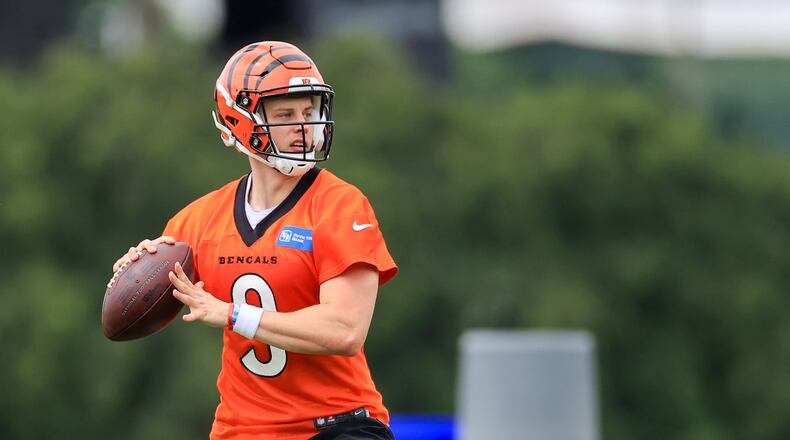On Tuesday, the receivers got to see how that would translate with him throwing long. Burrow started off a bit shaky with some overthrows and receivers having to wait on the ball at other times, but in his first time working on the deep balls during Organized Team Activities, it wasn’t unexpected or cause for concern.
“It’s one of the things we weren’t good enough at last year during the season,” Bengals coach Zac Taylor said Tuesday after practice. “We didn’t connect on them all today, but you get a chance now to go back and watch the tape, talk about the landmarks, talk about the tempo, talk about the timing and make those corrections for later this week, next week. And then it’s good tape to teach off of when you come back to training camp.”
Burrow threw a long pass of 67 yards last year but only had a handful of completions for more than 40 yards. The work done Tuesday is something that didn’t happen until training camp last year as the coronavirus pandemic wiped out the offseason workout program.
Taylor said 2020 won’t be an excuse, and the Bengals are fortunate to have time this offseason to work on improving. It was the plan all along to begin working on the deep ball in the third week of OTAs because Burrow and the receivers needed some time getting acclimated again before starting that process.
Burrow did throw some long balls from about 40 yards away to Tyler Boyd and Tee Higgins last week after practice, but Tuesday – the first OTA session of Week 3 – was the first time all the receivers and quarterbacks did such a drill together, and the distance was a bit longer.
“Part of it is we’ve been here two weeks now going into this week, and you don’t necessarily know what shape all these guys are in when they show up,” Taylor said. “And so, the first week you don’t want them just hauling it and running 45-yard go routes all the time and have them strain. That was part of our process, was Week 3 let’s start pushing the ball down the field a little more. Same goes with Joe. I didn’t know coming into where Burrow was going to be at. Now we’ve gotten a feel for everybody, so this week we wanted to get some of the timing and the landmarks down a little bit better.”
Asked what he thought of Burrow’s ability to get something on the ball, Taylor joked that he thinks Burrow can throw it “probably 90 yards right now.”
“No, I don’t know how far he can throw it, but it’s exciting,” he said. “He looks really good. I know a lot’s been made about the arm strength and velocity and all that, but he’s throwing the ball on time where it needs to go and that’s what I’m pleased about.”
Burrow is progressing well in his return to the field following the December surgery to repair his torn ACL and MCL. Up until Tuesday’s practice, he hadn’t been doing any drills that involved handing the ball off or being in close range to another moving player, but this week he’s started to do some play-action fakes to the running backs before throwing.
As for the receivers and their ability to make plays, Taylor likes what he is seeing from the group, which returns Boyd and Higgins and added Ja’Marr Chase with the fifth pick of the draft. Tight end C.J. Uzomah also is back from injury that sidelined him the final 14 games, and Drew Sample continues to grow as a pass-catcher.
It’s not been surprising that Burrow and Chase already have shown a chemistry previously developed at LSU in 2019.
“The ball is going to find the open guy or the guy with the best matchup,” Taylor said. “You feel good about the guys that you can roll on the field. You feel good about the depth at those positions as well. We have guys behind the starters that can come in and really challenge people. You just look at the way the targets were distributed last year. I think our starting three receivers, it was like 110, 106, 104 (targets). That’s about how you want it — equally distributed and then it’s up to them to make the most of those opportunities. It’s a group that’s a really strong group for us right now.”
About the Author
